Magen Cubed's Blog, page 15
January 25, 2014
Comic Book Review: Captain America #15
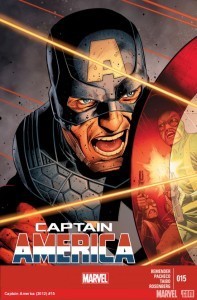 The final fate of Nuke! Dr. Mindbubble revealed! The Iron Nail’s war on the Capitalist West begins! Captain America unraveled! Story by Rick Remender, art by Carlos Pacheco.
The final fate of Nuke! Dr. Mindbubble revealed! The Iron Nail’s war on the Capitalist West begins! Captain America unraveled! Story by Rick Remender, art by Carlos Pacheco.
Nuke’s role in Iron Nail’s plot to terrorize the Western world reaches its conclusion in this issue. Tasked with cleaning up after Nuke’s recent rampage, Captain America, Falcon and SHIELD try to get to the bottom of this strange case of public scandal. Here we see the true intentions of Iron Nail, the former SHIELD agent turned super villain, with aspirations of undermining American Capitalism through Communist ideals. By manipulating government projects and other SHIELD castoffs, Iron Nail plans to wage war on the West with their own tools and experiments.
With Nuke in SHIELD custody, Cap and Fury begin the process of subverting Nuke’s mental programming, bringing him back from the brink of madness. He’s able to redeem himself, if only just, as a mentally unhinged soldier who was brainwashed by Iron Nail to undermine Cap and the American government. Unfortunately this is short-lived as Iron Nail detonates the explosives concealed within him and destroys his cell at The Hub, sending Cap, Falcon and Nick Fury off the nearby cliff and into the river below. This closes the issue, as the much-hyped Dr. Mindbubble, a psychedelic super soldier, makes his first appearance in the aftermath of Nuke’s death.
As this arc drags on, the antagonists continuously prove themselves as unfocused and outdated clichés. From the Cold War-era Communist extremism of Iron Nail, to the burnt-out post-Vietnam caricature of Nuke, and finally to the LSD-fueled 1960s throwback of Dr. Mindbubble, these concepts are out-of-date at best, and hackneyed at worst. This isn’t kitschy fun, as I think Remender intended in this strange clash of 1950s, 60s and 70s stereotypes. All three of these characters are all poorly defined and largely uninteresting, and bring little tension or excitement to the plot. Coupled with Remender’s lackluster writing of a blandly patriotic Cap, and equally flimsy characterizations of Fury and Falcon, this storyline feels like it’s going nowhere fast.
As for the art, Pacheco offers some pretty solid artwork in this issue, aided by a small army of colorists. He does make sensible design decisions throughout, although some pages more effective than others. I particularly liked much of the panel compositions in the helicopter sequence during the conversation between Cap, Nuke and Fury. However, many pages do fall flat, and don’t do much to salvage any visually interesting material from the script itself. Much of the color work, especially in the aforementioned helicopter sequence, is also hit or miss. There are some strong pages all the way through but, as with the rest of the issue, the highlights aren’t enough to tip the scale.
While this title started off strong in its opening arc, Captain America #15 just brings more of the same awkward storytelling and uninteresting villains that have since become routine. Pacheco does have some tricks up his sleeve, but in this issue, they are unfortunately few and far in between. Add to that the lackluster and unfocused scripting, and this book is quickly losing its footing.
January 9, 2014
Comic Book Review: New Avengers #13
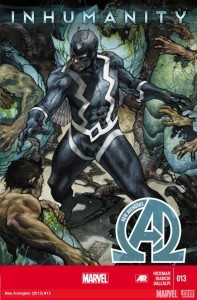 INHUMANITY TIE-IN! – “THE OTHER SIDE” With the consequences of Infinity fresh on their minds, tough decisions are made. The gathering of a new Illuminati. We learn more about the other beings related to the Incursions. Written by Jonathan Hickman with art by Simone Bianchi.
INHUMANITY TIE-IN! – “THE OTHER SIDE” With the consequences of Infinity fresh on their minds, tough decisions are made. The gathering of a new Illuminati. We learn more about the other beings related to the Incursions. Written by Jonathan Hickman with art by Simone Bianchi.
The Illuminati deal with the fallout of Inhumanity, but not in the way that we might expect. While the Earth-616 team builds a bridge into the next universe, the Illuminati of Earth-23099 face the consequences of the Terrigenesis bomb. On either side of the dimensional veil, both teams are trying to stop their respective destruction by any means necessary. With an interesting alternative line-up featuring Professor X, Magneto, Shuri and Mar-Vell, this team soon finds that the new Inhuman age brings about the Black Priests, who arrive during the latest incursion. 616 Reed and Black Swan collaborate on the bridge to track incursion points in other realities, allowing them to look on as the parallel Illuminati is decimated by the Black Priests before their Earth is consumed.
Despite the somewhat misleading summary, this tie-in offers an intriguing glimpse into the reality-spanning implications of Inhumanity, and gives us our first real look at the dangers Black Swan’s been foreshadowing. Hickman immediately shifts gears from the fall-out of Infinity to turn to the next leg of this slowly unfolding apocalypse, and does so through some solid scripting and attention to detail. It’s nice to see the true horrors that await the team out there as the 616 Illuminati watches the violence that may befall their own Earth. The Black Priests are an eerie and well-designed enemy, suitably off-putting given the pomp and circumstance surrounding their arrival. Seeing Earth-23099 Reed give his “Everything dies” speech at the beginning of the issue is a nice call-back to the beginning of the series, and reaffirms the cyclical nature of the incursions themselves. I would like to see Doctor Strange be better integrated in the main plot, now that he’s off on his separate spiritual journey, but that will likely take time and will be addressed in coming issues.
Simone Bianchi’s pencils are a charismatic departure from Deodato’s artwork, which I greatly enjoyed since replacing Epting. Bianchi’s lines are bold and energetic, the sharp and angular character anatomy adding a sense of motion through small flourishes in hair, fingers or clothing. This energy and dynamism makes for beautiful page design throughout, reflected in thoughtful and evocative panel composition. Likewise, the dramatic use of shadow, especially on and around eyes, is a delicate stylistic touch that I rather enjoyed seeing repeated throughout the issue. While I miss Frank Martin, I did really appreciate Dall’alpi’s work on this issue, with the lush warm gold and red tones contrasted by ghostly pale blues and greens.
Overall, New Avengers #13 is a solid start to the next leg of this storyline. Hickman gets the job done with this intriguing peek into alternate universes, and Bianchi and Dall’alpi bring it to the page with dynamism and strong color choices. A good read all around.
Comic Book Review: Black Widow #1
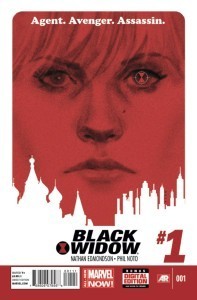 You’ve seen Black Widow as an Avenger and even an Agent of Shield. But on her own time she searches for atonement for her past as a KGB assassin—in ways of which those teams just wouldn’t approve. From the darkest corners of the Marvel Universe, Nathan Edmondson (Who is Jake Ellis?) and Phil Noto (Thunderbolts, X-23) bring you a new ongoing series as gorgeous and mysterious as Nastasha Romanov herself! By Nathan Edmondson and Phil Noto.
You’ve seen Black Widow as an Avenger and even an Agent of Shield. But on her own time she searches for atonement for her past as a KGB assassin—in ways of which those teams just wouldn’t approve. From the darkest corners of the Marvel Universe, Nathan Edmondson (Who is Jake Ellis?) and Phil Noto (Thunderbolts, X-23) bring you a new ongoing series as gorgeous and mysterious as Nastasha Romanov herself! By Nathan Edmondson and Phil Noto.
If you’re looking for a stylish title with slick visual presentation, exotic locales and a cool lead, Black Widow is the book you should be reading. Edmondson and Noto hit the ground running in this opening issue, taking on the enigmatic titular character on her meteoric rise into the upper tier of recognizable Marvel heroes. This book is fast-paced, visually stunning, and fun as hell to read, serving as a strong starting point for this title.
With Black Widow being featured in many ongoing books at the moment, it seems natural to try follow down the well-trodden path of punting an origin story. I half-expected it, having seen it so often during Marvel’s NOW continuous rebranding efforts, a rehashing any of the numerous iterations of her tragic backstory as to better explain it to new audiences. Instead, Edmondson chooses to focus on the action, dropping the reader in the middle of her latest job. This better serves the character and the book, establishing Natasha’s characterization, goals, and the overall tone of the story. Natasha is cool, confident and ruthlessly efficient, and Edmondson’s tight scripting explores all of these expected and often-lauded aspects of her character. Moreover, she’s beginning this series with a very specific goal: To make up for her past as a professional killer, and to reconcile the person she was with the person she is today. Whether she can finally come to forgive herself remains to be seen, and is a question that is left unanswered as the issue comes to its low-key conclusion.
There is plenty of action and adventure, in the same vein as The Bourne Identity or Mission Impossible, but I find Edmondson is most successful in that he still keeps the story grounded in Natasha’s personal quest for atonement. She makes a point of telling her manager and accountant Isaiah that she’s not doing contract work for the money, and instead makes sure that he transfers her compensation to her network of trusts. When she’s not helping the Avengers save the world, Natasha does very dangerous things for very dangerous people, but by her own set of principles and to her own ends. Natasha never compromises her identity in the pursuit of her cause, and is never portrayed as anything but a compelling and capable spy. These aren’t terribly new or original themes in the genre at large, and the plot is pretty safe and familiar. However, in seeing these themes applied (and applied very well) to a female character, it makes for a very fresh and satisfying read.
The real star of this book is Noto and his stellar artwork. His soft, painterly colors create a beautiful balance with the energy and dynamism of his page layouts. Moody palettes and lighting techniques establish locales with an effectiveness I don’t often see, creating a distinctive visual tone for the issue. The softened filter that Noto applies throughout the book gives a delicate, gauzy emphasis to key panels, contrasting the brutal efficiency of the character with her inherent femininity. Black Widow is as beautiful as she is deadly, and Noto explores that through graphic narrative without coming off as patronizing or obvious, a feat I rarely see done effectively.
From start to finish, Black Widow #1 is a strong introduction to the series. I highly recommend this book, whether you’re a longtime fan or new to the character. This is a great title and I look forward to reading more in the coming year.
December 22, 2013
Comic Book Review: Uncanny Avengers #15
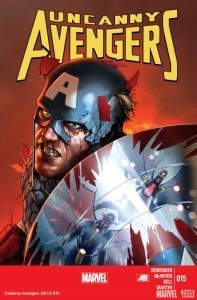 After the numerous deaths last issue the Avengers Unity Squad is left shattered and broken. The fate of humanity rests in the hands of Thor, but can the God of Thunder defeat the combined might of two Apocalypses? At the same time The Wasp fights for her life against the unparalleled might of The Sentry! Written by Rick Remender with art by Steve McNiven.
After the numerous deaths last issue the Avengers Unity Squad is left shattered and broken. The fate of humanity rests in the hands of Thor, but can the God of Thunder defeat the combined might of two Apocalypses? At the same time The Wasp fights for her life against the unparalleled might of The Sentry! Written by Rick Remender with art by Steve McNiven.
In the fallout of issue #14’s shocking deaths, the Apocalypse Twins continue toward their goals of rapturing mutant kind and paving the way for humanity’s destruction. Having foreseen the inevitable betrayal of the recently killed Scarlet Witch and Wonder Man, Uriel and Eimen harvest their combined powers to direct the abducted mutants to the Ark. Here we see Wasp face off against Sentry with the help of Thor in a spectacular and gruesome encounter. This is a satisfying throw-down that reaffirms Wasp’s place in the team, despite her somewhat unsure footing in earlier issues.
Meanwhile, with Rogue dead and Wolverine held by Daken and Reaper, Captain America and Havok try to intervene but are quickly captured by the twins. Beaten down by Eimen, Cap has to accept the hand that he played in splintering the Unity squad and getting his comrades killed. He must helplessly watch the twins’ plan reach fruition as the Celestial Executioner appears to destroy Earth, brought back to avenge the Celestial Gardeners felled by the twins with Thor’s axe Jarnbjorn. As Wasp and Thor are confronted with his previous follies by Uatu the Watcher, the Celestial Executioner decides Earth’s fate, dovetailing several of the series’ numerous threads in the issue’s dire cliffhanger.
Remender continues to raise his already seemingly impossible stakes in this issue, as this arc makes good on the pacing and energy set up by #14’s grim turn of events. He uses his rotating point of view formula to deliver a tightly scripted and action-oriented story, cashing in on much of the build-up going on in earlier issues with generally satisfying results. The action is great, but so is much of the exposition, which, despite his sometimes lackluster narration, Remender uses quite well. This is a book about regrets, as we see how the actions of many of our key players led them down this road and allowed for the twins to make their power play. From Thor’s youthful bravado to Cap’s ideological hypocrisy, Wolverine’s personal failings to Rogue’s inability to forgive Scarlet Witch, all of these actions have real consequences. Remender offers us a timely critique of the X-Men’s internal strife, as well as the state of the superhero community in the general, constantly engaged in interpersonal brawls and ideological disputes.
Even for these strengths, like much of the series so far, the immense scope of this story shortchanges it in other areas. Characterizations are skewed to further the plot, power levels adjusted to make for bigger and bigger fights, and in the chaos Sunfire is completely absent. All too often it seems that characters are relegated to the status of props to fulfill specific roles in the plot, such as the insipid handling of Wonder Man and Scarlet Witch’s doomed ad hoc romance, while the twins themselves seem to overcome every obstacle thrown at them with ease. Yes, it’s all very dramatic, and it does make for a fun thrill ride with some great action sequences. But sometimes the characterizations in this series just feel forced, details and narrative subtleties lost amid constantly rising tensions. This issue, unfortunately, is no exception.
All of that said, McNiven has proven an invaluable addition to the book. His artwork really carries the burden of this arc, but does so nearly flawlessly. The action is stunning, his page layouts not only visually pleasing but engaging to read. His panel transitions make the most of the narrative tension through thoughtful framing and design, composing panels that are fluid and dynamic throughout. Truly Wasp’s showdown with Sentry was the highlight of the book, adding a touch of the grotesque and otherworldly to an already grim graphic narrative. Additionally, Martin’s strong use of yellows and reds really heighten the emotional stakes of these action sequences, drawing on evocative color palettes to make the artwork pop.
Despite some bumps and bruises, Uncanny Avengers #15 is another tight and fairly consistent chapter in Remender’s arc. It’s energetic and action-packed, and definitely uses the controversial last issue as a sound springboard in moving forward. McNiven’s art continues to really move the title in a positive direction, and makes for a solid read all the way around.
Comic Book Review: FF #15
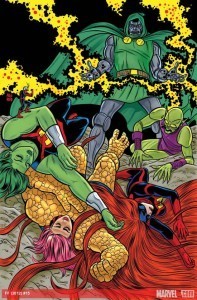 Invasion Latveria: the Video Game! Four stand-in replacement heroes and a dozen kids versus Dr. Doom, now transformed into the ultimate power in the universe: Doom the Annihilating Conqueror! What a time to run out of quarters! Game over, man! From writers Matt Fraction and Lee Allred, with art by Mike Allred and colors by Laura Allred.
Invasion Latveria: the Video Game! Four stand-in replacement heroes and a dozen kids versus Dr. Doom, now transformed into the ultimate power in the universe: Doom the Annihilating Conqueror! What a time to run out of quarters! Game over, man! From writers Matt Fraction and Lee Allred, with art by Mike Allred and colors by Laura Allred.
All bets are off as the FF launches its final assault on Doctor Doom and his villainous cadre, getting some help from the Inhumans along the way. The ragtag alliance are able to punch through Doom’s defenses and rescue Alex Power’s parents, showing off all the big personalities and dynamics at play with the kids in the middle as they use their android stand-ins to do all the heavy lifting. In the ensuing chaos, Ravonna disappears from Doom’s lair. We meet up with her later to see visiting with Franklin and Valeria Richards, currently being teleported from their parents’ sides by Lockjaw, to find out that Ravonna is an adult Valeria.
With everything coming to a head, Old John makes a failed attempt at killing Doom and Uatu the Watcher appears in Doom’s lair. Kid Immortus seizes the moment to merge with Doom, to become Doom the Annihilating Conqueror, but Doom consumes the power for himself. He takes out both Annihilus and Kid Immortus before turning his attention to Uatu, only for the FF to appear and be quickly dispatched. However, Ant-Man arrives on the scene to finish the fight, closing the book’s penultimate issue.
This big crazy storyline finally comes to a head, plotted by Matt Fraction and scripted by Lee Allred. All the numerous moving parts of this scheme come together surprisingly well, even as every other page simply spills over with action and character banter. Amid the chaos, Fraction and Allred do offer some interesting twists along the way, such as the Ravonna reveal and the appearance of the Inhumans, as well as good interpersonal moments for the kids and team. Mike Allred’s artwork provides the visual cohesion this story needs, unifying all the pieces and the various fight scenes into a fun and inviting parade of brawling androids and Doom-Bots. This clever narrative trick keeps the other tiny subplots and character interactions relevant, and broadens the scope to encompass the full breadth of this all-out assault. At times Lee Allred’s dialogue can come off as a bit jokey, lacking some of the subtle absurdity and heart of Fraction’s earlier issues, but it’s a small complaint.
Fun, clever, and always enjoyable, FF #15 is another solid issue in a charming series. I’ll be sorry to see it go next month after #16. This has been one of my favorite reads of 2013.
December 12, 2013
Comic Book Review: Captain America #14
Falcon and Captain America in the fight of their lives! The Iron Nail’s revenge takes form. No more greed. No more pollution. No more you. No more me. From here out there is only us! What is Nuke’s true mission? What does it have to do with the Weapon Minus program? From writer Rick Remender and artist Carlos Pacheco.
Captain America and Nuke’s brawl finally comes to its conclusion in this issue, as SHIELD sends Cap in to be seen bringing the deranged Nuke and avoid a further public relations nightmare. However, this plan to save America’s image abroad backfires with potentially devastating consequences. As an American reporter on the ground documents Nuke’s jingoistic rampage, Falcon must make a choice protect journalistic freedom or follow orders. While I give credit to Remender for an earnest set-up, the execution falls flat in more ways than one.
As seen in last month’s issue, the book opens up on Cap and Nuke squaring off in Nrosvekistan. SHIELD is working in the background as Fury and Hill try to quash Nuke’s killing spree, using Cap as a symbol of peace-making to calm the media storm to come. Realizing that rage will get him nowhere, Steve tries reason with Nuke soldier-to-soldier, appealing to his humanity in coming in and seeking treatment for his psychological issues. His ideologies wounded by the poor treatment of returning American soldiers by “draft-dodgers” and “punks,” Nuke believes that striking out against civilians abroad will protect America’s image. Persuaded by Cap’s cowboy speech Nuke nearly agrees to return to America, but when he sees the journalist snapping pictures of him and Cap talking, he flies into another rage.
Falcon is able to fly the journalist to safety while Nuke and Cap brawl, where he must take her camera as ordered. There they discuss the SHIELD’s legitimacy as a peace-keeping organization and her rights as journalist to report the facts to the global community. Faced with the inevitable suppression of Nuke’s violence, Falcon chooses to let her keep the camera before he flies to aid Cap. Already traumatized by the loss of Sharon and Ian, Cap is driven over the edge by Nuke’s politically-motivated slaughter and nearly kills Nuke. Falcon arrives to stop Cap and a beaten and bloodied Nuke breaks down, having only wanted to honor his country and make Captain America proud of his service. Nick Fury arrives to collect Nuke, and Falcon must face the consequences when they all learn that the reporter already published her photos online.
I tried to withhold my judgment of this storyline as it unfolded and allow Remender the room to make his case, but everything about this issue rubs me the wrong way. Overall, it is a well-crafted book with solid pencils by Pacheco and color palettes by White, and makes the most of the plot as given. And to his credit, Remender does deliver a straightforward action story that asks some potentially interesting philosophical questions of Falcon and Cap respectively. However, it’s ultimately Remender’s execution that rings hollow, undermining everything good about this title.
The Iron Nail, the former SHIELD agent bent on undermining Western governments and acting as the shadowy villain of this entire affair, is an outdated Cold War throwback. When he first showed up in this arc I assumed he was a repurposed villain of the 1960s, a lesser-known Mandarin doppelganger. After some cursory research, I was shocked to find that he was developed for this storyline. His role as a stereotypically Chinese symbol of anti-American dogma just feels uninspired and lazy. It all reads as a misdirected attempt to grapple with the fears of a bygone era rather than a substantive modern threat, as Remender takes no time to develop the character or his agenda.
Similarly, Nuke feels very out of place as a Vietnam-era relic. His creation in the mid-80s as a product of the Vietnam War made his emotional instabilities and nationalist ideologies understandable. All political correctness aside, he served as a disgruntled representation of the generation of soldiers that had returned home, ostracized for fighting in a war they were drafted into. However, like Iron Nail, I fail to see how any of this is either particularly relevant or weighty in 2013, faced with other immediate contemporary problems. While I see that Remender is trying to draw parallels between Vietnam and the conflicts in Iraq and Afghanistan, the execution is deaf to the cultural climate of present-day America, making Nuke’s actions and motivations incoherent. Yes, he is insane, but he’s also a one-note cliché.
My third issue with this storyline is Remender’s characterization of Captain America himself. After some genuine character development and soul-searching as seen in The Odd War of Dimension Z, Remender has managed to finally reduce Cap to a completely flat, catch phrase-spewing ideologue. All the emotional depth of his character has been stripped, leaving him a hollow symbol solely defined by his military service. After reading Kathryn Immonen’s well-rounded and earnest portrayal of Cap in the recent Avengers Annual Christmas issue, full of such humor, empathy and substance, I’m really frustrated by Remender’s portrayal.
Despite its solid production value, this storyline is lackluster at best, and problematic at worst. Overall this issue is disappointing, feeling like a giant leap backwards for the title rather than a step toward future continuity. Perhaps in coming issues Remender can find a way to salvage this plot, but I sincerely doubt it at this point.
Comic Book Review: Inhumanity #1
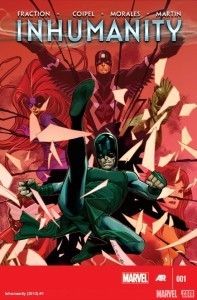 After INFINITY, The Marvel Universe has changed. The Avengers find themselves face to face with Karnak who has discovered the secret of The Inhumans THAT will shake The Marvel U to its core. From writer Matt Fraction and artist Olivier Coipel.
After INFINITY, The Marvel Universe has changed. The Avengers find themselves face to face with Karnak who has discovered the secret of The Inhumans THAT will shake The Marvel U to its core. From writer Matt Fraction and artist Olivier Coipel.
Following the events of Jonathan Hickman’s Infinity event, Matt Fraction takes up the reins after the fall of Attilan to steer the Inhumans in a shocking new direction. Will this event prove to more cohesive and enduring than the last? Will the fate of the Inhumans really change the status quo of the Marvel Universe? It’s hard to say for sure, but for an opening issue, Inhumanity #1 does have a lot going for it. Artist Olivier Coipel and colorist Laura Martin certainly argue a strong case, making for a visually pleasing reading experience that puts Fraction’s script on solid footing.
As the issue opens on a devastated New York City, the Avengers arrive on the scene to find Karnak roaming the Upper West Side in a daze. After a brief skirmish, Karnak is taken to Avengers Tower while the team tries to deal with the fallout of Attilan’s destruction. With Black Bolt missing and the rest of the Inhumans scattered, Earth’s heroes are scrambling to understand the situation they find themselves thrust into. The crux of the book is the mystery of Black Bolt’s Terrigenesis bomb and the unanswerable questions that arise. Following a retelling of theInhuman genesis story, we see the implications both the past and the future will have for the new Inhumans springing up across the globe, throwing the world into chaos as Karnak explains what he knows to the Avengers. Using his psychic abilities, he foresees the horrible future that awaits the Inhumans and the hand that he inevitably plays in it. Even as Medusa pleads with him, he escapes the tower to plunge to his death on the street below.
While a little slow in some places, Fraction delivers a well-written opening issue for this event. He does a solid job of integrating key information from Hickman’s previous storyline, as well as revisiting the Inhuman origin story, without bogging everything down in the exposition. This is an exposition-heavy issue, but it comes together well through the strength of his scripting. The sagas of the Inhumans are core to the overarching mythology of the Marvel Universe and Fraction approaches this story with appropriate severity and attention to detail, without letting the script feel too dramatic or overwritten. There are some circular conversations that arise in Karnak’s captivity scene, but it doesn’t detract from the general quality the writing. Moreover, his distinctive character voices and interactions help to break up the tension through his treatment of the Avengers and Medusa, and they add an enjoyable dimension to the overall story.
As always, Coipel delivers crisp dynamic artwork, beautifully complemented by Martin’s color palettes. His handling of Medusa is especially lovely, capturing her strength and regality as well as her loss and inner turmoil at the state of her people. Leinil Francis Yu provides the pencils for the Inhuman origin segment, supplying a distinctive pictorial break that still meshes well with the tone of the overall story. As strong as the script is, Coipel steps up to offer his evocative line work and subtle flourishes in bringing it all home.
Full of mystery and might, sorrow and humanity, Inhumanity #1 sets up this event through great art and writing. Overall this is a solid and intriguing read that follows up Infinity to build on Hickman’s arc, taking the Inhumans in a new direction. Whether this chapter of Marvel mythology lives up to the hype remains to be seen, but so far it’s looking to be an intriguing ride.
December 10, 2013
Fleshtrap Available Now
Alright, here we go, everybody: My debut horror novel FLESHTRAP is now available from a retailer near you. (And by near you, I mean, on the internet. Because the internet is near and dear to all of us, isn’t it?) Do you like horror? Do you like dark fiction? Do you like eldritch-style creepiness about monsters and men, and how you can’t always tell the difference between the two? Do you like horror that explores personal relationships and family dynamics? If you answered yes to any of these questions, then this book is for you. Or for your friends. Or for your mom. You know, if you wanted to buy more than one! The holidays are coming up and all, and who doesn’t love the gift of entrails and madness?
Just what is the book about? If you haven’t been aware of all of my spamming, it goes something like this:
Casey Way has been haunted by visions of his dead pedophile father for the last twenty years, tormented by hazy recollections of his father’s murder at the hands of his stepmother. The trauma has left Casey burdened with guilt, which has manifested in debilitating insomnia and violent hallucinations. As the anniversary of his father’s murder approaches, his step-sister Mariska takes him back to the scene of the crime: their childhood home, to confront their past and finally get some closure.
Instead, something follows Casey back out into the world, something ugly, violent, familiar. It begins a vicious spiral of insanity as people around him begin disappearing and dying, hiding behind the faces of Casey’s loved ones. Somehow tied to his father’s murder, Casey begins digging into his fragmented memories for an answer. What he finds instead brings Casey face-to-face with his greatest fears as he struggles to end the nightmares that have haunted all of their lives.
But don’t take my word for it. From an early reader review of the novel,
The draw was the uncertainty. There’s more to it than that, but I really can’t overstate how much I love not immediately knowing.
Most of the time I know – or at least have a good idea – of what’s going to happen when I read a fiction novel. (To be clear, that isn’t always a bad thing, but it can bore after a while, make you want something riskier than a well loved trope). Certain characters are Safe. Certain things simply Won’t Happen. The danger stays inside the lines. Fleshtrap doesn’t really have those standard set of safety nets – you won’t have a sense of those conventions to buoy you through a character’s next poor choice. Terrible things have already happened to Casey and continue to happen. Bad decisions abound, and so do bad people.
And oh, are there bad people. Which brings me to the second thing I really liked about this novel; the monsters.
This is a horror story, and there are supernatural elements, but [Magen Cubed] seems to know that the the scariest thing in the room is usually the people in it. In that sense Fleshtrap reminds me a lot of horror mangakas Kazuo Umezu and Junji Ito. An eldritch-like abomination may be stalking the protagonist, but there’s some real ambiguity when it comes to where you should direct your fear, at the who or the what (and that question becomes more fun at the end of the novel).
Sound good? I’d like to think so. The novel is already hovering in the Amazon Best Sellers standings in Gay & Lesbian Horror and I’m hoping that it stays that way for the foreseeable future. So you can pick up your copy today from Amazon, Barnes & Noble, or Post-Mortem Press. If you find that you still don’t want to pony up the cash, you can always enter to win a free copy at Goodreads until December 25th. (See? You have options!)
And lastly, if you like it, all I ask is that you let people know. Rate it, leave a review, recommend it to a friend. If you read it back in the day as an online serial, do me a solid and leave some feedback. I don’t have some huge marketing budget behind me for this book, and a lot of this business is based on word-of-mouth. I’m deeply appreciative of the link-sharing and promotion that people have already done for this book, but I still have a long way to go. So if you can, if you choose, let people know about it. Every little bit helps.
Thanks, and happy (?) reading.
December 3, 2013
Let’s Talk about Fleshtrap: Meet the Cast
If you’ve been paying attention the last few weeks, you’d know from the avalanche of spam that my debut novel FLESHTRAP is coming out on December 10th. Some of you probably read it way back in the day when it was a free-to-read online serial, but if you didn’t, then it’s probably new to you. So if you’ve already pre-ordered your copy, you’re looking to pick it up soon, or you’re still not sure it’s your speed, I figured I’d take a minute to talk about the book a bit more. This is the cast, their world, and everything you need to know.
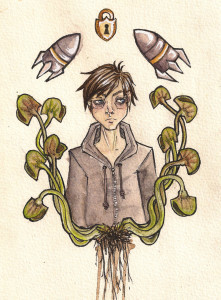
Casey Way by Anna Rose
Casey Way. Our protagonist. Library cataloger. Insomniac with daddy issues as far as the eye can see.
Casey borrowed the space at the end of Paul Orman’s black sofa. His dark jeans and t-shirt helped him fade into the upholstery, cross-legged, shrinking away between the cushions he slouched against. Paul’s office was a cave carved out of cinderblocks and mahogany on the eighth floor of a high-rise building, black leather and wood stain stretching from wall to wall. In the center of the room was a high-backed leather armchair with heavy pleats and ornate brass decorations, an end table, and the sofa. Paul on one side, Casey on the other, silence between them.
“What would you like to talk about today, Casey?”
Flanked by the tall arms of his chair, Paul was sallow with thinning gray hair and grayer eyes. The bony peaks of his skull recalled Max Schreck, Count Orlock, Nosferatu, stalking dark corridors and staircases. The notion that Paul Orman had ever instructed a classroom of future therapists made Casey uneasy. That Paul held a fond place in Joel’s heart as his thesis advisor ultimately left a bad taste in his mouth.
“I don’t know.” He said nothing about vampires. “What should we talk about?”
Casey saw Paul on Tuesday mornings with black coffee still fresh in his mind. Joel made terrible coffee, half-caff piss-water, not at all like the black tar Casey needed in his veins every day. Joel made up for it on most mornings, when squeezing Casey’s small bicep Joel kissed him goodbye at the door and warned him to play nice. For the first three sessions Casey agreed. This morning Casey had promised nothing.
“You know it’s up to you, Casey.” Paul smiled vacantly. “You can talk about whatever you like here. It’s a safe space.”
Casey shrugged. “There’s not a lot to talk about. I told you that last week.” And the week before that.
“Humor me, Casey.”
“I’m pretty sure Joel already told you everything you needed to know. I mean, you’re on his Christmas card list, right?”
“Joel only came to me and asked me to review your case. That was all.”
“Then you already know I’m just here so Joel will feel better, right?” The thought of Joel sitting bright-eyed and gullible in the front row of Paul’s yawning classroom, some cathedral-auditorium, all dark glossy wood fixtures and overcompensation, made Casey uncomfortable in a way he couldn’t fully articulate. “And you get paid either way, so I think it’s a win-win no matter what happens.”
“I don’t think so. Now I would like to more about you, Casey.” Paul reached for the pen and legal pad sitting on the arm of his chair. “I think hearing it from you would be more useful. So tell me a little bit about yourself.”
Casey folded his hands and sighed. “Where should I start?”
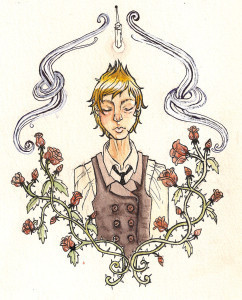
Joel Britton by Anna Rose
Joel Britton. Casey’s boyfriend. Therapist and rape crisis counselor. Eternal optimist, even when it gets him in trouble.
The sun was gone by the time the soft glide of the patio door told Casey he was no longer alone. Joel wrapped his arms around Casey’s shoulders from behind and sighed against his hair, pressing himself into the curve of Casey’s spine. Casey closed a hand around the cross of Joel’s wrists and leaned back into the contact.
“Hey.”
“Long day?” Casey asked around his cigarette, limp and nearly-burnt.
Joel closed his eyes and breathed from the nape of Casey’s neck. “It usually is.”
Joel Britton’s office was a closet in the Turning Point Counseling Center with chipped wood paneling and smoke damage on the ceiling. It afforded him enough space for a desk, two chairs, and a filing cabinet. He spent his Monday-through-Friday each week amid the clutter of opened case files and Pepsi cans in front of his computer, the telephone wedged into the crook of his shoulder when he had time between appointments. When he had a spare moment he checked his messages on his smart-phone, mostly news or updates on soccer matches. Joel invited his patients into his office for counseling most days; others he jogged the four blocks to the court-house to go with them to trial. On particularly busy days he responded to calls from officers in Sex Crimes to aid with taking statements or filing reports, either at the hospital or down at the station. On the speed-dial of at least five cops, three lawyers and two doctors, Joel’s days were longer than most.
This afternoon he held a young woman’s hand, waiting in the hallway outside the courtroom. Her name was Stephanie and she was twenty-one, a theater major from Scarsdale. She had to swear on a Bible and recall being raped in the parking lot of a laundromat, because her dryer had broken and a man with a knife was waiting in a station wagon. Joel didn’t want to talk about that.

Mariska Kovol by Anna Rose
Mariska Kovol. Casey’s sister. Late-night DJ at 92.5 KVBS. Wants the best for her brother, even if she has to drag him to it kicking and screaming.
If he concentrated, Casey could hear Mariska’s voice on 92.5 KVBS, the smoky rumble of her laughter slipping into the dining room between tracks of ZZ Top and Led Zeppelin. She was the late-shift DJ, seven at night to one in the morning. Monday-through-Friday, Classic Sounds with Mariska. It was easy to imagine her sitting in a hazy studio booth in her favorite cowboy boots, all long legs and jeans, wearing sunglasses at night like a poster from a cheap exploitation movie about drug culture and rock-and-roll. The way she looked since she was old enough to spend money at thrift shops on the clothes her mother hated, where she would drag Casey after school and hide bags full of old combat boots and leather jackets in his book bag so her mother wouldn’t see.
For all my little lovelies out there who can’t sleep tonight, Mariska said. The way she always did between commercial breaks, voice dark from too many cigarettes. You know who you are and you know why you’re here, so just shut the hell up and listen to some good music.
November 30, 2013
Comic book review: New Avengers #12
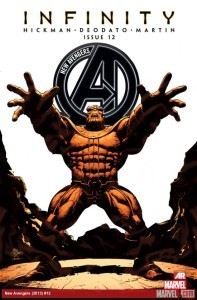 INFINITY TIE-IN – “THE WORLD WE HAVE.” The House of Black Bolt crumbles. New friends, new enemies.
INFINITY TIE-IN – “THE WORLD WE HAVE.” The House of Black Bolt crumbles. New friends, new enemies.
From Jonathan Hickman and Mike Deodato.
Serving as the epilogue to Infinity, this issue follows the members of the Illuminati in the aftermath of Thanos’s march cross Earth. The full consequences of their battle to save the planet are finally revealed as Black Panther is accused of treachery for his alliance with Namor. Confronted by his sister, T’Challa can’t tell her the truth about the Illuminati or their activities at the Necropolis, and is in turn banished from the city. This leads to an uncomfortable scene with Namor, who applauds T’Challa for his bravery and commitment and welcomes him to “the very edge,” a fellow king without a kingdom.
Meanwhile, Black Bolt and his brother Maximus discover that the Terrigen Bomb diminished Black Bolt’s abilities. How this has happened isn’t explained, but Maximus agrees to keep his brother’s secret. A likewise struggling Doctor Strange locks himself away in the Sanctum Sanctorum, distressed by his recent possession by Ebony Maw. He warns Wong to bar him inside while he uses the Blood Bible and resolves to never be used as a pawn again. Back at the Necropolis, Reed, Hank and Tony let Black Swan out of her captivity, satisfied in having defeated the Builders and Thanos. Laughing, Swan tells them that far worse await the Earth – Mapmakers, Sidera Maris, and The Masters. As the Illuminati learns, the Builders were just the beginning, and no matter what they do, everything will die.
Closing this chapter of the series, this issue serves as a solid postmortem of the events of Infinity, as well as a teaser for future arcs. Seeing how this event affected Black Panther, Doctor Strange and Black Bolt respectively was quite satisfying on a character development standpoint. With the revelation in Infinity #6 that Black Bolt always intended to detonate the Terrigen Bomb, how he will be able to come through this without his full strength remains to be seen. It puts a lot of this sweeping melodrama into a more digestible context, and opens up some interesting new possibilities. I’m curious to see how Black Swan will fit into this group dynamic, and how Namor and T’Challa relate to each other moving forward.
With all of that said, it does feel a little anti-climactic that, after twelve issues, the world is still ending. And not only is the world still ending, but Hickman has yet to explain how the Builder and Thanos storylines intertwine, or how this plays into the title’s overarching plot. Of course I realize the world is always ending, as is the nature of superhero fiction, but the cliffhanger feels a bit predictable and unresolved. Instead of having the time to really process what readers want to believe is a victory, the Illuminati simply shift gears to address the next, larger threat. It serves its purpose, setting the stage for the upcoming Inhumanity event, but it feels a bit empty nonetheless.
Even for that, New Avengers #12 is a solid afterward to the Infinity storyline. It suffers from a few bumps and bruises, but the strength of Hickman’s scripting and Deodato’s pencils carry it to an enjoyable conclusion. Overall a good read, and critical to readers following these characters into the next event.



